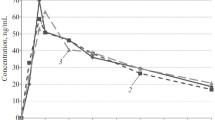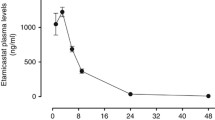Summary
The effects of isosorbide dinitrate (ISDN) on plasma renin activity (PRA) and plasma catecholamines were investigated in conscious trained dogs. The following results were obtained:
-
1)
A single oral application of 2 and 4 mg/kg ISDN led to increases in heart rate, decreases in central venous and arterial blood pressure and an increase in PRA over a period of 3 to 4 hours. The observed haemodynamic effects were comparable to those of clinically applied doses in men.
-
2)
The repeated administration of 2, 4, 8 and 16 mg/kg ISDN given three times a day orally over a period of 5 days had no influence on the basal PRA values in the morning.
-
3)
A cumulation of the increase in PRA after ISDN was observed only if the interval between the oral application of 4 mg/kg was reduced to three hours or less. Despite of the persistent increase in PRA with hourly dosage, no influence could be found on the simultaneously measured plasma catecholamine levels in this study.
The results give further evidence for the very important role of renin in the homeostasis of the circulation, especially in situations of a decreased circulatory blood volume. The effect of ISDN on the reflex increase in PRA was shown to be within the range of 3 to 4 hours, indicating a duration of action of ISDN over the same period of time. A cumulative reflectory increase in PRA does not seem to be relevant for the therapeutic use of ISDN because of the usual dosage interval above three hours during the day and the mostly drug free period during the night. However, frequent application with dose intervals shorter than three hours could lead to an unwanted counterregulation with increased PRA levels, and hence an attenuation of the therapeutic effect.
Zusammenfassung
Die Wirkung von Isosorbiddinitrat (ISDN) auf Plasma-Reninaktivität (PRA) und Plasma-Katecholaminspiegel wurde an wachen Hunden untersucht.
Einzelapplikation von 2 oder 4 mg/kg ISDN p.o. bewirkte einen Anstieg der Herzfrequenz, Abfall des zentralvenösen und arteriellen Blutdruckes und einen Anstieg der PRA über 3 bis 4 Stunden. Die hämodynamischen Wirkungen waren jenen klinisch verwendeter Dosen vergleichbar.
Wiederholte Gabe von 2, 4, 8 und 16 mg/kg ISDN 3mal täglich durch 5 Tage hindurch führte zu keinerlei Veränderung der morgens gemessenen PRA-Werte.
Eine Kumulation des PRA-Anstieges konnte bei mehrmaliger oraler Gabe von 4 mg/kg ISDN nur dann gesehen werden, wenn ein Dosisintervall von 3 Stunden oder noch kürzer eingehalten wurde. Trotz eines langanhaltenden PRA-Anstieges bei stündlicher Verabreichung von ISDN konnte keinerlei Veränderung der ebenfalls bestimmten Plasma-Katecholaminspiegel gefunden werden.
Die Untersuchungen unterstreichen die wesentliche Rolle des Renins in der Homöostase des Kreislaufes, insbesondere bei vermindertem zirkulierendem Blutvolumen. Der reflektorische Reninanstieg nach ISDN war über 3 bis 4 Stunden nachweisbar, so daß eine ebensolange Wirkdauer von ISDN anzunehmen ist. Eine Kumulation des gegenregulatorischen Reninanstiegs scheint von eher geringer therapeutischer Bedeutung zu sein, da die üblichen Dosenintervalle über 3 Stunden liegen und außerdem die Nacht meist als medikationsfreies Intervall hinzukommt. Wenn jedoch häufige Einnahme mit Intervallen unter 3 Stunden stattfindet, könnte der gegenregulatorische Anstieg der PRA zur Geltung kommen und den therapeutischen Effekt abschwächen.
Similar content being viewed by others
References
Bailie, M. D., L. E. Davis, R. Loutzenhiser: Intrarenal secretion of renin in the dog: effect of furosemide. Amer. J. Physiol.224, 425–430 (1973).
Brennan, L. A. jr.,R. L. Malvin, K. E. Jochim, D. E. Roberts: Influence of right and left atrial receptors on plasma concentrations of ADH and renin. Amer. J. Physiol.221, 273–278 (1971).
Brown, J. J., D. L. Davies, A. F. Lever, J. I. S. Robertson, A. Verniory: The effect of acute haemorrhage in the dog and man on plasma-renin concentration. J. Physiol.182, 649–663 (1966).
Brown, T. C., J. O. Davis, C. I. Johnston: Acute response in plasma renin and aldosterone secretion to diuretics. Amer. J. Physiol.211, 437–441 (1966).
Claybaugh, J. R., L. Share: Vasopressin-renin, and cardiovascular responses to continuous slow hemorrhage. Amer. J. Physiol.224, 519–523 (1973).
Carmichael, P., J. Lieben: Sudden death in explosive workers. Arch. environm. Health.7, 424–439 (1963).
Cubeddu, L., E. Santiago, R. Talmaciu, G. Pinardi: Adrenal origin of the increase in plasma dopamine β-hydroxylase and catecholamines induced by hemorrhagic hypotension in dogs. J. Pharmacol. exp. Ther.203, 587–597 (1977).
Da Prada, M., G. Zürcher: Simultaneous radioenzymatic determination of plasma and tissue adrenaline, noradrenaline and dopamine within the femtomole range. Life Sci.19, 1161–1174 (1976).
Dukey, J. W.: In Analysis of Variance. Ed.H. Scheffé. Verlag Wiley (1959).
Fiedler, V. B., J. Scholtholt: Haemodynamic effects of molsidomine. Arzneim.-Forschg. Drug Res.28 (II), 1605–1612 (1978).
Flaherty, J. T., P. R. Reid, D. T. Kelly, D. R. Taylor, M. L. Weisfeldt, B. Pitt: Intravenous nitroglycerin in acute myocardial infarction. Circulation51, 132–139 (1975).
Graham, R. M., M. R. Muir, J. M. Hayes: Differing effects of the vasodilator drugs, prazosin and diazoxide on plasma renin activity in the dog. Clin. exp. Pharmacol. Physiol.3, 173–177 (1976).
Grandjean, B., G. Annat, M. Vincent, J. Sassard: Influence of renal nerves on renin secretion in the conscious dog. Pflügers Arch.373, 161–165 (1978).
Haber, E., T. Koerner, L. B. Page, B. Kliman, A. Purnode: Application of a radioimmunoassay for angiotensin I to the physiologic measurement of plasma renin activity in normal human subjects. J. clin. Endocrin.29, 1349–1355 (1969).
Higgins, J. T. jr.,J. O. Davis, J. Urquhart, M. L. Olichney: Increased plasma level of renin in experimental secondary hyperaldosteronism. Amer. J. Physiol.207, 814–820 (1964).
Honig, C. R., St. M. Tenney, P. V. Gabel: The mechanism of cardiovascular action of nitroglycerine. Amer. J. Med. 910–923 (1960).
Holtz, J., E. Bassenge, A. Kolin: Hemodynamic and myocardial effects of longlasting venodilation in the conscious dog: analysis of molsidomine in comparison with nitrates. Basic Res. Cardiol.73, 469–481 (1978).
James, St. K., R. C. Hall: The nature of renin released in the dog following haemorrhage and frusemide. Pflügers Arch.347, 323–328 (1974).
Klock, J. C.: Nonocclusive coronary disease after chronic exposure to nitrates: Evidence for physiologic nitrate dependence. Amer. Heart J.89, 510–513 (1975).
Morikawa, Y., K. Muraki, Y. Ikoma, T. Honda, H. Takamatsu: Organic nitrate poisoning at an explosives factory. Arch. environm. Health14, 614–621 (1967).
Niehues, B., W. Krimmel, V. Hombach, M. Tauchert, D. W. Behrenbeck, H. H. Hilger: Wirkung von Molsidomin auf die Hämodynamik in Ruhe und unter Belastung bei Patienten mit koronarer Herzkrankheit. Dtsch. med. Wschr.103, 853–856 (1978).
O'Rourke, R., V. S. Bishop, P. A. Kot, J. P. Fernandez: Hemodynamic effects of nitroglycerin and amyl nitrite in the conscious dog. J. Pharmacol. exp. Ther.177, 426–432 (1971).
Pettinger, A. W., K. Keeton: Altered renin release and propranolol potentiation of vasodilatory drug hypotension. J. clin. Invest.55, 236–243 (1975).
Riley, R. L., A. Scriabine, L. S. Watson: Effect of timolol on hydralazine-induced increase in plasma renin activity in spontaneously hypertensive and normotensive Rats (39567). Proc. Soc. exp. Biol. Med.153, 454–458 (1976).
Tanigawa, H., S. L. Dua, T. A. Assaykeen: Effect of renal and adrenal denervation on the renin response to slow haemorrhage in dogs. Clin. exp. Pharmacol. Physiol.1, 325–332 (1974).
Thames, M. D., Zubair-Ul-Hassan, N. C. Brackett jr.,R. R. Lower, H. A. Kontos: Plasma renin responses to hemorrhage after cardiac autotransplantation. Amer. J. Physiol.221, 1115–1119 (1971).
Vatner, St. F., M. Pagani, J. D. Rutherford, R. W. Millard, W. Th. Manders: Effects of nitroglycerin on cardiac function and regional blood flow distribution in conscious dogs. Amer. J. Physiol.234, H244-H252 (1978).
Watkins, L. jr.,J. A. Burton, E. Haber, J. R. Cant, F. W. Smith, A. C. Barger: The renin-angiotensin-aldosterone system in congestive failure in conscious dogs. J. clin. Invest.57, 1606–1617 (1976).
Weber, M. A., I. R. Thornell, G. S. Stokes: Effect of hemorrhage with and without fluid replacement on plasma renin activity. Amer. J. Physiol.225, 1161–1164 (1973).
Zehr, J. E., J. A. Hasbargen, K. D. Kurz: Reflex suppression of renin secretion during distention of cardiopulmonary receptors in dogs. Circulation Res.38, 232–239 (1976).
Zileli, M. S., O. Gedik, N. Adalar, S. Caglar: Adrenal medullary response to removal of various amounts of blood. Endocrinology95, 1477–1481 (1974).
Author information
Authors and Affiliations
Additional information
With 5 figures and 1 table
Rights and permissions
About this article
Cite this article
Benke, T., Kraupp, O., Placheta, P. et al. The effect of single and repeated oral doses of isosorbide dinitrate on plasma renin activity and plasma catecholamine levels in conscious dogs. Basic Res Cardiol 75, 400–409 (1980). https://doi.org/10.1007/BF01907587
Received:
Issue Date:
DOI: https://doi.org/10.1007/BF01907587




